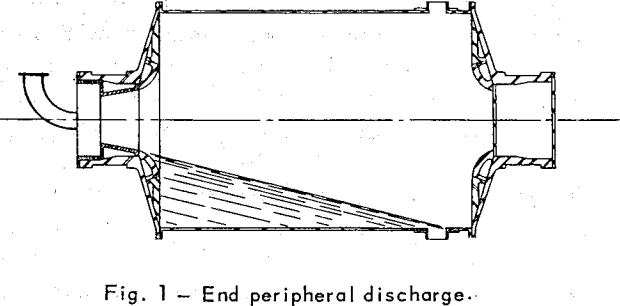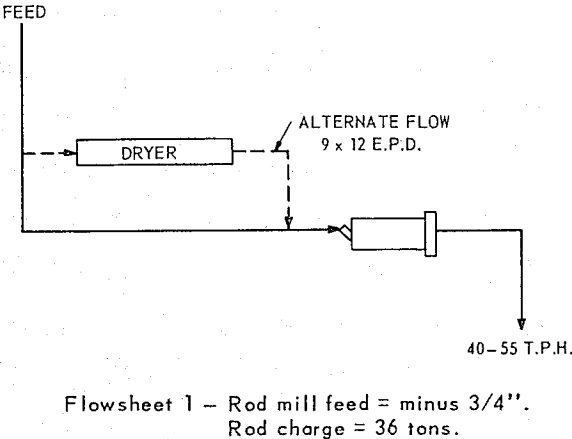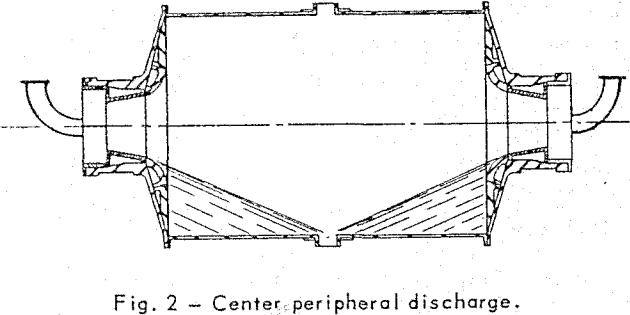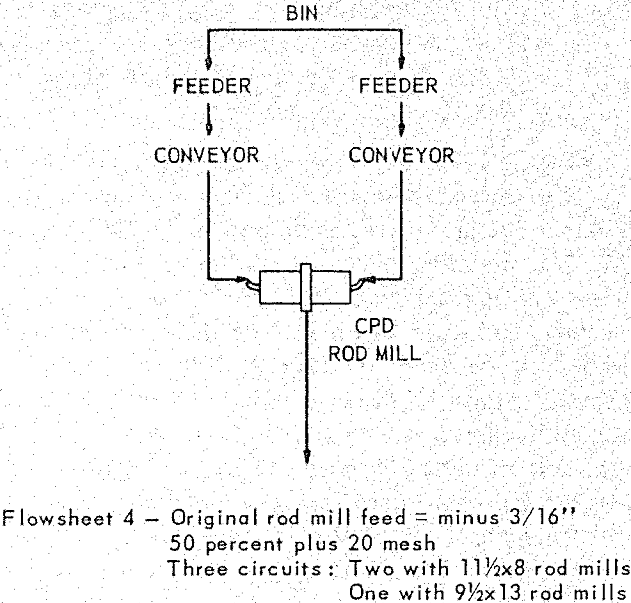Wet grinding rod mills have been used for 50 years to grind ores and to make specification sand. The application of wet grinding rod mills is well understood. Until recently, there have been very few installations of dry grinding rod mills. The basic principles learned from wet grinding rod mills that were used in the application of dry grinding rod mills are :
- It is possible to extrapolate the performance of 5′ and 6′ diameter wet grinding rod mills into larger diameter rod mills with the larger mills performing as predicted. Wet grinding rod mills as large as 14′ diameter (inside shell) by 20′ long using 19.5′ long rods are in use operating satisfactorily.
- Wet grinding rod mills generally grind more efficiently when the fines are left in the mill feed than when the fines are removed from the feed.
- Wet grinding rod mills produce little tramp oversize and generally can be operated in open circuit except when very close control on the top size in the product is required. When operated in closed circuit, the circulating load is normally less than 100%.
- The power required for the desired grind can be accurately determined from the work indices obtained from rod mill grindability tests on the material to be ground. Where required it is necessary to apply inefficiency factors for oversize feed and for larger or smaller than normal ratios of reduction.
Lead Ore Sinter Plant – Flowsheet 1
A 9’x 12′ end peripheral discharge rod mill is used to grind return sinter, limerock and furnace slag as principal feed materials with crude and low grade siliceous ore and miscellaneous smelter by-products as minor feed materials. Each material is ground separately and is stored for blending into sinter plant feed or as a final product. Oversized rod mill feed is crushed to approximately minus ¾” for feeding to the rod mill. Rod mill feed is dried when the operator finds it necessary. The dryer is operated

only when required. The operator’s guide points for dryer operation are the rod mill noise level and plugging of the mill discharge chute and/or the screw conveyor handling the mill discharge. No tests have been run to establish the maximum moisture levels that permit satisfactory mill operation.
The rod mill products in terms of percent passing 20 mesh are :


An 11′ x 14′ center peripheral discharge rod mill (see Figure 2) with an 800-hp motor was installed to produce 200 metric tons per hour of minus 6 millimeter sinter plant feed from iron ore crushed to minus ½”. As sinter feed, a minimum of minus 100 mesh was desired in the rod mill product. The crushed ore contained about 40% passing 6 millimeters.
Rod mill grindability tests were run on this ore from which a rod mill selection was made. A closed circuited 6′ x 12′ center peripheral discharge rod mill was installed in a pilot plant to verify the mill and milling circuit selection. Only the circumferential row of shell liners at each end of the mill had lifters on them. There were 12 discharge ports.
Applying the proper correction factor for dry grinding to the best test data, it lined up fairly well with the grindability tests. The 11′ x 14′ center peripheral discharge rod mill selection was confirmed. The 11′ x 14′ rod mill had the same basic liner configuration as the pilot mill. The only basic difference between this mill and the pilot mill was it had sloping end liners with about an 18 slope while the test mill had vertical end liners. This was done to improve feeding problems encountered in the pilot mill. The large mill had large diameter short length bearings to accommodate-60° straight spout feeders.

Iron Ore Pelletizing Plant Feed — Flowsheets 3A and 3B
A 13′ x 18′ center peripheral discharge rod mill was installed to grind 200 to 220 long tons per hour of minus ¼” iron ore to 5 to 10% plus 10 mesh for feeding to balling discs in an iron ore pelletizing plant. Moisture content of the feed was 5 to 8%. The original feed contained 60 to 65% passing 10 mesh.
Grindability and laboratory scale grinding tests were run after which pilot plant tests were run in a 9½’ x 13′ center peripheral discharge rod mill operating in open circuit. This mill was charged with a 35% charge consisting of 2½” and 2″ rods. The rod mill ground from 60 to 80 long tons per hour making a product with 4 to 8% plus 10 mesh. The mill drew about 400 hp. Due to the moisture in the feed, the spout feeders tended to plug. This problem was solved by blowing air into the lower portion of the feeder. The mill had Lorain “C” type liners with 20 lifters to the circle.

charged with 2½” and 2″ rods. Rod bending, breaking and tangling was immediately encountered and prevented continuous operation. The rod charge was replaced with 4″ and 3″ diameter rods which relieved the problem somewhat. The grind was between 10 to 15% plus 10 mesh which was too coarse for good balling. Several experiments were made to try to obtain desired fineness of grind and to further correct the rod tangling, bending and breakage.
Iron Ore Pelletizing Plant Feed – Flowsheet 4
Two 11½’x 18′ dry grinding center peripheral dis-

charge rod mills were installed each to grind an average of 80 long tons per hour of minus 3/16″ iron ore fines to 2 to 3% plus 20 mesh with 35 to 40% passing 325 mesh. This ore is a coarser grained and more gritty type ore than the ore ground in the plant described above. The mill feed averages 15% plus 4 mesh and 50% plus 20 mesh. The rod mill feed contained 3 to 5% moisture. The rod mill product is fed to balling discs. The mill shell liner lifters were spaced on 11″ centers and the lifters were 4″ high, with straight edges. The mill speed was 61% of critical speed. The mills were initially charged with a 105-ton rod charge (32% of mill volume) in equal amounts of 2″, 3″ and 3½” rods. The mills drew 1200 hp with only rods in the mill and 1100 hp when grinding ore with 4% moisture. The feed rate varied from 50 to 70 long tons per hour with the mill product being 20% plus 20 mesh. Rod tangling, breakage and bending caused a very irregular operation.

